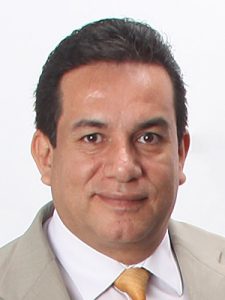When I finally get through to Jose Acosta, he is shopping at Lowe’s.
“Is this still an OK time to talk?”
“Sure,” Jose — a general contractor — responds. “I’m just trying to find a door for a home I’m working on.”
I quickly discover Jose is adept at multitasking.
At 53 years old, this father of six is a general contractor in South Florida, co-hosts a radio show three times a week with his wife, and pastors a Brethren in Christ church of around 150, mostly migrant families.
Bivocational Ministry

Jose Acosta, pastor, Jesus Redentor de Vidas, Greenacres, Fla.
Jose is what we in the biz call a bivocational pastor (immediately, the prefix “bi” seems insufficient, but we’ll leave it for now).
If that term is new for you, my guess is it’s fairly self-explanatory. But just in case: A bivocational pastor is a person who serves as a pastor in a church and also carries one or more other jobs in order to supplement his or her salary.
The apostle Paul is often referenced as the archetypal example of this role. In Acts 18 we learn Paul is a tentmaker, presumably this income allowed him to support his ministry in times when alternative income was necessary. Hence why this role can sometimes be referred to as “tentmaking.”
Given our current cultural conceptions of pastors (that a pastor is a full-time, professional position, funded by a church), you may assume bivocational pastors are only a small subset among all pastors. In reality, not only is bivocational ministry quite common, but its numbers are also growing.
This is largely tied, not to strategy, but to necessity.
A Growing Trend
According to a recent study by Gallup, the median attendance for places of worship dropped over 20% the past 20 years to an average of about 50% of Americans attending a church, synagogue, or mosque in 2018.1
This has been accompanied by a corresponding drop in the average church budget.
Some experts predict that, if trends continue, giving to churches may be down as much as 70% in 30 years. Of course, all of this comes to bear on the number of churches in the United States with full-time, paid clergy. In 2010, 71% of churches had at least one full-time pastor, but by 2015 that had fallen to 62%.2
While U.S. Brethren in Christ congregations may not precisely mirror that trend (in the last few years we’ve seen slight increases in our overall attendance and percentage of pastors who are paid and full time versus part time), we are wise to pay attention to it. And it’s significant to note that 40% of our pastors are already bivocational, above the U.S. average.
It’s likely pastors will increasingly need to be nimble and creative as we consider how to lead our congregations in engaging a rapidly changing culture, and that includes how we think about funding our ministries.
A Matter of Strategy

Dave Fulmer, pastor, Summit View BIC, New Holland, Pa.
Author Ed Stetzer argues that a shift toward bivocational ministry will help our leaders live out the gospel. In his Christianity Today article “Bivocational Ministry as an Evangelism Opportunity,” Stetzer observes, “Bivocational ministry offers a great opportunity for evangelism. Bivocational pastors are uniquely positioned to live out their pastoral calling as the lead missionary to their local community.”3
This sentiment is reflected in the attitudes of many BIC pastors who practice bivocational ministry.
Dave Fulmer is a pastor at Summit View BIC Church in New Holland, Pennsylvania. Using a collaborative leadership model, Dave and his co-pastor, Todd Harmon, each carry a half-time role at the church while also working an outside job.
Previously working in a corporate job, Dave, 60, has been serving in various bivocational ministry roles for more than 15 years. He notes several key advantages to being a bivocational pastor.
“Working outside the church helps me stay connected to the daily realities of the people in our church family,” Dave says. “Hopefully, it makes my preaching a little more relevant because I have at least some sense of what ‘working folks’ might be going through.”
Jose agrees. “Working another job allows you to relate to people. You know what they are going through. You can feel their pain. You’re working as hard as they are working,” he says.
In fact, it’s served as a real opportunity for Jose to connect with the very people he’s trying to reach.
“Many of the guys who go to my church are my subs (contractors),” he says. “They’re my roofers, the tile guys, etc.”
Calling to Lancaster City

Heather Brickner, pastor, Branch & Vine, Lancaster, Pa.
For church planters Heather and Micah Brickner, the decision to become bivocational was both pragmatic and theologically driven.
In 2016, they moved to Lancaster, Pennsylvania, to start the congregation Branch & Vine. To help supplement their ministry incomes, Heather got a job working in the local school district in an emotional support classroom, and Micah began serving in a local nonprofit.
But, like Dave and Jose, they valued the opportunity to work alongside the people they were hoping to reach.
“In The Message translation of John 1:1, we read that Jesus ‘moved into the neighborhood,’” Heather reflects. “So when we felt called to the City of Lancaster we believed our primary calling was to the city. Our call to being pastors was actually secondary.”
Having worked in full-time ministry roles since graduating from college, the couple, now in their late 20s, wanted the experience of working in the community in order to know firsthand what challenges and opportunities existed there.
Both of them enjoyed these experiences. Yet they quickly determined this was not a great long-term strategy for them.
Within 6 months Micah sensed that his role in the church plant would be to offer support to Heather: He would serve as a key volunteer but keep his job at the nonprofit. Heather continued to feel called to serve as lead pastor. However, the toll of working with students with emotional trauma during the week was beginning to weigh on her. She found herself expending all her emotional and physical energy with the students, leaving precious little for the church.
Heather needed to shift gears. Resigning from teaching, Heather is now the part-time pastor of Branch & Vine (at least 28 hours a week), allowing the new church financial flexibility to focus on mission and Heather two days a week to stay home with her one-year-old. In addition, she also serves on the ministry leadership team of the Atlantic Conference.
Ideal versus Practical

Keith Miller, pastor, LifePath Church, Newark, Del.
When asked about the biggest challenge of bivocational ministry, the other pastors I interview echo the Brickner’s sentiments: too much to do and not enough time.
“I feel burnt out all the time,” Jose confesses. “I honestly don’t know which way to run most days.”
“This really requires that you set boundaries,” Dave emphasizes. “Pastoral work is never done anyway, but when you couple that with some other job it becomes really challenging.”
I recently called up church planter Keith Miller to discuss bivocational ministry. Keith planted LifePath Church in Delaware eight years ago. During some seasons leading the church, Keith has worked bivocationally. Currently, he serves the church full time.
I mentioned the Stetzer article and the idea that perhaps bivocational pastors could be the cutting edge of evangelism. Keith chuckled.
“It’s easy to romanticize bivocational ministry. And there are some real advantages,” says Keith. “But bivocational ministry is hard. And if your second job is not the right type of job, you won’t have the margins to be a good pastor.”
Keith clarifies that “the right type of job” outside of the church needs to be one where you can “come and go, and it doesn’t take an emotional toll on you.”
Dave echoes this sentiment, “Second jobs need to be practical, not relationally intensive. For me, my favorite side job was always painting. With painting, you knew when you were done. As a pastor, you’re never really done.”
In an ideal world, bivocational ministry wouldn’t be necessary say each of the pastors interviewed for this article. They all list multiple items — from reading and personal development to investing in leaders and casting vision for the future — that they are convinced would enhance their ministry if only they had the time to give to it.
And yet, with all the challenges, my interviewees see real value and opportunity in bivocational ministry.
Each comment on the freedom experienced from not being fully dependent on the church as their sole source of income.
It allows them to try different models and creates less pressure around numbers.
Most are using models that line up with their ideals rather than being simply pragmatic.
Whether those ideals are shared leadership structures or a more engaged community model, these individuals feel really positive about the type of ministry they are able to do, even though it is challenging.
The Cost of Being a Bivocational Pastor
Consider Jose’s journey to bivocational ministry. While pastoring at a church led by an American pastor, Jose began to be captured by the growing need among Hispanic migrants in the local community.
His church wasn’t reaching them.
Jose recognized the migrant community needed a church focused exclusively on their needs and, quite literally, spoke their language. But no funding was available. The only way he could respond to the need was to develop his own funding source (i.e., get another job).
Now as a bivocational pastor, he regularly ministers to over 150 migrant workers who are facing innumerable challenges, from language barriers to deportation. As you would imagine, many of these people don’t have much.
“I often tell my wife and kids that we just can’t ask for more (money) from our congregation. They’re giving what they can.”
Jose puts me on hold for a few minutes while he fields a call from one of his subs. It’s a Monday, Jose’s “day off” from church.
It’s also his busiest day of contracting work.
I feel the need to let him go. I’ve already taken nearly an hour of his time. And yet, Jose isn’t anxious to get off the phone. He speaks lovingly of his congregation and gratefully of the freedom to involve his wife and children in his ministry and to be able to afford to put his children through college.
He seems hungry for a listening ear, someone with whom he can share the joys and the struggles of holding onto a vocational call that feels at once so beautiful and yet so costly.
As we say goodbye, I ask, “Is there one thing you’d want people to know about bivocational ministry?”
Jose pauses. What comes next feels at once like both a confession and also a simple matter of fact:
“It’s hard. It takes a toll.”
1. Frank Newport, “Church Leaders and Declining Religious Service Attendance,” Gallup, September 7, 2018; Jeffrey M. Jones, “U.S. Church Membership Down Sharply in Past Two Decades,” Gallup, April 18, 2019.
2. “Second Shift: Thriving in Bivocational Ministry,” LifeWay, September 29, 2016.
3. Ed Stetzer, “Bivocational Ministry as an Evangelism Opportunity,” Christianity Today, October 15, 2017.


